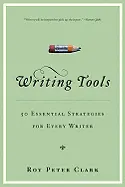
Writing Tools - by Roy Peter Clark
ISBN: 0316014990Date read: 2015-11-05
How strongly I recommend it: 7/10
(See my list of 430+ books, for more.)
Go to the Amazon page for details and reviews.
Great advice on how to be a better writer. Unfortunately the author’s writing style is distracting. How strange to take advice from someone not taking it themselves. Like a drunk telling you not to drink. Right after reading this book I gave it a terrible rating because of that, but now I realize its points and advice (in my notes, below) are truly great.
my notes
Begin sentences with subjects and verbs. Make meaning early. Place emphatic words in a sentence at the end.
The 2-3-1 tool of emphasis: the most emphatic words or images go at the end, the next most emphatic at the beginning, and the least emphatic in the middle.
The difference between a good adverb and a bad adverb? Compare “She smiled happily” and “She smiled sadly.” “Sadly” is good because it changes the meaning.
It took several years and hundreds of readings before I noticed I had written “create” and “creating” in the same sentence. It was easy enough to cut “creating,” giving the stronger verb form its own space. Word territory.
The power of the written word is to make you hear, to make you feel, to make you see.
In his book 100 Ways to Improve Your Writing, Gary Provost created this tour de force to demonstrate what happens when the writer experiments with sentences of different lengths:
This sentence has five words.
Here are five more words.
Five-word sentences are fine.
But several together become monotonous.
Listen to what is happening.
The writing is getting boring.
The sound of it drones.
It’s like a stuck record.
The ear demands some variety.
Now listen.
I vary the sentence length, and I create music.
Music.
The writing sings.
It has a pleasant rhythm, a lilt, a harmony.
I use short sentences.
And I use sentences of medium length.
And sometimes, when I am certain the reader is rested, I will engage him with a sentence of considerable length, a sentence that burns with energy and builds with all the impetus of a crescendo, the roll of the drums, the crash of the cymbals - sounds that say listen to this, it is important.
The purpose of paragraphing is to give the reader a rest. The writer is saying: ‘Have you got that? If so, I’ll go on to the next point.’
Paragraphing is also a matter of the eye. A reader will address himself more readily to his task if he sees from the start that he will have breathing-spaces from time to time than if what is before him looks like a marathon course.
If a writer wants the reader to think something is the absolute truth, the writer should render it in the shortest possible sentence. Trust me.
In the anti-math of writing, the number three is greater than four. The mojo of three offers a greater sense of completeness than four or more.
Use one for power.
Use two for comparison, contrast.
Use three for completeness, wholeness, roundness.
Use four or more to list, inventory, compile, and expand.
When the topic is most serious, understate; when least serious, exaggerate.
Understatement = “Pay no attention to the writer behind the curtain. Look only at the world.”
Hyperbole = “Watch me dance. Aren’t I a clever fellow?”
“If it sounds like writing, rewrite it.” — Elmore Leonard
Readers read for two reasons: information and experience. There’s the difference.
Reports convey information. Stories create experience.
Reports transfer knowledge. Stories transport the reader, crossing boundaries of time, space, and imagination.
Reports point us there. Stories put us there.
The famous “Five Ws and H”: Watch what happens when we unfreeze them, when information is transformed into narrative:
Who becomes Character.
What becomes Action. (What happened.)
Where becomes Setting.
When becomes Chronology.
Why becomes Cause or Motive.
How becomes Process. (How it happened.)
Elmore Leonard: “Leave out the part that readers tend to skip.”
But which part is that?
“Thick paragraphs of prose you can see have too many words in them. The writer has gone into the character’s head. BUT: I’ll bet you don’t skip dialogue.”
Human speech, captured as dialogue on the page, attracts the eyes of the reader and, if done well, advances the story.
Foreshadow conclusions. Plant important clues early.
Learn how to craft the cliffhanger. “And there stood one of the oddest human beings I’d ever laid eyes on.”
The simple need to learn what he looks like drove me to the next chapter.
Build your work around a key question.